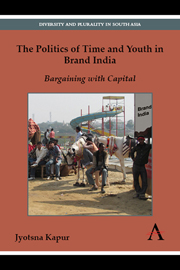Book contents
- Frontmatter
- Dedication
- Contents
- Acknowledgments
- Introduction: After Me the Flood
- Chapter 1 Brand India's Biggest Sale: The Cultural Politics and Political Economy of India's “Global Generation”
- Chapter 2 Arrested Development and the Making of a Neoliberal State
- Chapter 3 For Some Dreams a Lifetime is Not Enough: The Rasa Aesthetic and the Everyday in Neoliberalism
- Chapter 4 An “Arranged Love” Marriage: India's Neoliberal Turn and the Bollywood Wedding Culture Industry
- Chapter 5 Ek Haseenah Thi (There Once Was a Maiden): The Vanishing Middle Class and Other Neoliberal Thrills
- Conclusion
- Notes
- References
- Index
Chapter 1 - Brand India's Biggest Sale: The Cultural Politics and Political Economy of India's “Global Generation”
Published online by Cambridge University Press: 05 March 2014
- Frontmatter
- Dedication
- Contents
- Acknowledgments
- Introduction: After Me the Flood
- Chapter 1 Brand India's Biggest Sale: The Cultural Politics and Political Economy of India's “Global Generation”
- Chapter 2 Arrested Development and the Making of a Neoliberal State
- Chapter 3 For Some Dreams a Lifetime is Not Enough: The Rasa Aesthetic and the Everyday in Neoliberalism
- Chapter 4 An “Arranged Love” Marriage: India's Neoliberal Turn and the Bollywood Wedding Culture Industry
- Chapter 5 Ek Haseenah Thi (There Once Was a Maiden): The Vanishing Middle Class and Other Neoliberal Thrills
- Conclusion
- Notes
- References
- Index
Summary
Capital demands more youthful workers, fewer adults.
—Karl MarxOutsourcing is a story of the past. We now want people to see India as a manufacturing base, as the youngest nation with fortunate future demographics.
—Indian minister of commerce Kamal NathEver since the Indian state officially turned to neoliberalism in 1991, it has also became commonplace in business-bureaucratic policy to speak of the nation as “Brand India,” “India Inc.” or “India Shining.” Brand India is the favored term of choice for the Congress Party — the party currently in power with Prime Minister Manmohan Singh. The Bharatiya Janata Party (BJP), the political party previously in power with an openly Hindu fundamentalist agenda, preferred India Shining. Regardless of the specific nomenclature, what this represents is the MBAization of governance, such that the nation is imagined as a brand to be marketed, positioned, and sold on the global market. There is a revolving door between the government and the International Monetary Fund (IMF) and World Bank, from Prime Minister Manmohan Singh, who earlier worked at the World Bank, to Raghuram Rajan, the current chief economic advisor at the Indian Ministry of Finance and a previous chief economist and director of research at the IMF.
- Type
- Chapter
- Information
- The Politics of Time and Youth in Brand IndiaBargaining with Capital, pp. 21 - 48Publisher: Anthem PressPrint publication year: 2013



